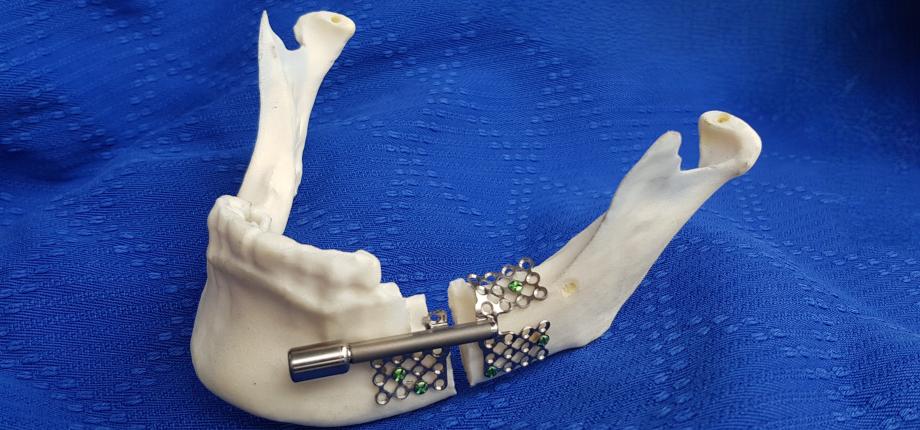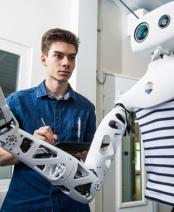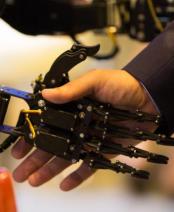Mechanics and maxillofacial surgery, the winning duo

In the movie Welcome to Gattaca, the character played by Ethan Hawke evolves in a eugenicist society and seeks to realize his dream of becoming an astronaut, even if this means modifying his physical characteristics. In this case, to lengthen his femurs with the help of distractors. While the situation may be the stuff of dystopia, bone-lengthening devices do exist, notably for mandibles. In the latter case, the device consists of two plates affixed to either side of a cut lower jaw. They are then connected by a worm screw, whose rotation gradually moves the two pieces of bone apart.
“The screw is operated daily using a transcutaneous rod to lengthen the bone by around 1mm per day. Most of the time, it's the parents who carry out the procedure, with all the apprehension and pain that this can entail for both their child and themselves,” explains Jean Boisson. A specialist in the mechanics of magnetized structures, the LMI researcher joined forces with Natacha Kadlub, a professor at Necker Hospital and a practitioner in maxillofacial surgery and pediatric plastic surgery, to develop a mandibular distractor free of this torture rod.
Mastering the lengthening process
Jean Boisson's work focused on the magnetic field, magnet interactions and magnet design, while Natacha Kadlub focused on the device's adaptability to the surgical environment. Their distractor is made up of internal and external permanent neodymium-iron-boron magnets, magnetized diametrically (editor's note: cylindrical or disk-shaped magnets, for example, are magnetized on their diameter, so the magnetic poles are located on the curved surface of the magnets and not on their flat face) and activated by an instrumented motor. The activator, which contains the external magnet, exerts a torque on the internal magnet. If the mechanical torque transmitted between the two magnets is sufficient, it is possible to stretch the soft tissues and perform distraction “remotely”, without the need for a transcutaneous rod, while ensuring, thanks to sensors implanted in the activator, that the right number of turns is applied at the right time.
To achieve this result, the researcher modeled the two magnets involved. “There are physical models that determine the magnetic energy of interaction between two permanent magnets like ours. We realize that, in addition to the power and distance between them, the geometry of the magnets influences the torque transmitted”. By comparing his model with his experiments, the researcher was able to determine the torque and magnet size required for the new device. “A final challenge was to make them biocompatible without altering their physical properties”. This challenge was met thanks to the expertise of a company based in the South of France, capable of encapsulating Jean Boisson's magnets using cold titanium plasma spraying.
Since 2017, the two scientists have been accompanied towards a technology transfer process by Satt Paris-Saclay (Société d'accélération et de transfert technologique) via a licensing agreement with ENSTA. Their device is now ready to enter this phase, and a company will adapt it to its production lines with a view to bringing it to market within the next 5 years.This project has also earned the two researchers the Fondation des Gueules Cassées 2024 prize (also a sponsor of the project).
Enriching scientific knowledge
In the meantime, Jean Boisson and Natacha Kadlub's work has paved the way for more fundamental avenues of research. The French Defense Innovation Agency (AID), which reports to the Délégué général pour l'armement (DGA), and the interdisciplinary Engineering for Health Center (E4H), have been supporting this research for several years. To develop their device, the scientists looked at the mechanics of the periosteum, the tissue that covers all the bones in the body, including the mandible, and on which the distractor is implanted. “We had to assess the forces applied to the rod by the soft tissues located around the fracture inflicted on the mandible. We therefore determined the behavioural laws of the periosteum and demonstrated that it is indeed the periosteum that offers the greatest resistance to distraction”, explains the researcher. The scientific literature also points out that the periosteum, which is also involved in bone remodelling, may accelerate healing depending on its mechanical state. Its adhesion to bone has also not been sufficiently documented, and a thesis is currently underway to characterize it and understand its role.
Another thesis has also been launched on the impact of the magnetic field of neodymium-iron-boron magnets on cells and bone remodeling. It is part of the MAGBONE collaborative project, supported by AID and the Centre interdisciplinaire d'études pour la défense et la sécurité (CIEDS).“Studies suggest better cell differentiation and higher bone densities. We'll be looking into this further, in conjunction with Lariboisière Hospital, to see whether the mechanical properties of periosteum and bone created under magnetic field differ from those of native tissue,” concludes Jean Boisson.

About
Jean Boisson is a teacher-researcher at ENSTA's Laboratoire de Mécanique et ses Interfaces. He studies the mechanical action of magnetic structures and biomechanics. His research focuses on isolating and understanding the influence of magnetic fields on the mechanical properties of complex systems.
Jean Boisson obtained a PhD in theoretical physical chemistry from the École Normale Supérieure de Paris (ENS) in 2008. After various post-doctoral assignments at the CEA, Université Paris-Saclay and ENS, he joined ENSTA as a teacher-researcher in 2012, joining the Institute of Mechanical Sciences and Industrial Applications (IMSIA).
>> Jean Boisson's personnal page on ENSTA website
>> Jean Boisson on Google Scholar
*LMI : an own unit, ENSTA, Institut Polytechnique de Paris, 91120 Palaiseau, France













